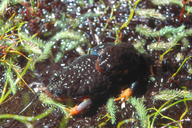|
Distribution and Habitat
Country distribution from AmphibiaWeb's database: Australia
Population and Distribution
Spicospina flammocaerulea was discovered in 1994 (Roberts et al. 1997). When first described in 1997, the species was only known from three well separated peat swamps in the s.w. corner of WA (Roberts et al. 1997). However, survey work undertaken from 1997 to 2000 raised the number of known populations to 27, all occurring near the WA s. coast, e. and n.e. of Walpole (Roberts et al. 1999; Burbidge & Roberts 2001). This species has a limited area of occurrence (approximately 305 km2), small area of occupancy (135 ha) and fragmented range (Roberts et al. 1999; Burbidge & Roberts 2001). No reliable data on population size is available, however, counts of males have been recorded at several sites from 1994-1997 (Roberts et al. 1999). Surveys of calling males usually report less then ten individuals, however 150 males were estimated to be present at Trent Road (Bow R.) in 1997 (Roberts et al. 1997). An apparent decline in the number of calling males has been recorded at Mountain Road (n. and s.) where 120 males were observed calling in 1994 and three years later only 2 males were recorded (Roberts et al. 1999). The actual population size at sites with few or no calling males is unknown (D. Roberts pers. comm.). Two sites with a long history of visitation and no calling activity contained individuals in 2000 (D. Roberts pers. comm.).
Fourteen populations are on private property n., w. and e. of Bow Bridge, with the remainder in the Mt Franklin NP or on land designated to form part of the Mt Roe-Mt Lindesay NP but not yet declared (Roberts et al. 1999; D. Roberts pers. comm.).
Habitat
Spicospina flammocaerulea is a habitat specialist. The region from which S. flammocaerulea has been recorded is thought to have undergone a change from a subtropical wet to a seasonally arid climate about 5 to 6 million years ago and the peat swamps where the species occurs are considered to be relicts of an earlier environment (Wardell-Johnson et al. 1996). The persistence of the species in well separated swamps is no doubt attributable to this change in environment (Wardell-Johnson et al. 1996). The species is found in isolated and permanently moist peat based swamps with organically-rich soils (Roberts et al. 1997), in a high rainfall area of moderate relief with granite outcrops and associated ranges of hills rising to 300-400m (Roberts et al. 1999). These sites have a high moisture content in the soil and are protected from climatic extremes, often by local seepages that maintain water availability uncharacteristically into spring and summer (Roberts et al. 1997).
Life History, Abundance, Activity, and Special Behaviors
Reproduction
Males call between Oct. and Dec. from shallow pools, water seepages, large hollows containing water or in open water along creek margins (Wardell-Johnson et al. 1996; Roberts et al. 1997). Less than 200 eggs are deposited singly and may be supported by algal mats just below the waters surface (Roberts et al. 1997). The tadpole stage is presumably free swimming (Roberts et al. 1997). Explosive breeding appears unlikely as numbers of calling males have been observed to remain relatively stable over extended periods throughout the breeding season at some sites (Roberts et al. 1999).
Invasive species
Excavation by feral pigs are common in swamps close to the type locality and pigs may have a direct impact on frog survival (Roberts et al. 1997). However, monitoring of known populations and adjacent control sites from 1997-1998 has shown little indication of pig damage (Roberts et al. 1999).
Trends and Threats
An extremely small geographic range makes this species particularly susceptible to local catastrophes. An apparent decline in frog numbers at one locality (Mountain Road, Mt Franklin NP) following wildfires in 1994 suggests a possible risk from fire (Roberts et al. 1999). Frequency of fire varies between localities but the majority of sites have experienced wildfires in the last 50 years (Roberts et al. 1999). This suggests some capacity to recover post-fire but the time and conditions required for full recovery, which could set an optimal fire interval and intensity regime, are unknown (Roberts et al. 1999). Fires which burn the substrate (peaty swamps) or fire regimes which lead to a greater propensity of substrate ignition, may well be detrimental to the persistence of the species (Roberts et al. 1997). Loss of vegetation through fire or disease (such as the fungus Phytophthora) may alter soil water tables affecting both availability of breeding sites and peat formation and maintenance (Wardell-Johnson et al. 1996; Roberts et al. 1997).
Fourteen populations are on private property n., w. and e. of Bow Bridge, with the remainder in the Mount Franklin NP or on land designated to form part of the Mount Roe-Mount Lindesay NP but not yet declared (Roberts et al. 1999; D. Roberts pers. comm.). There are no threats to populations on publicly owned lands that cannot be controlled by appropriate management but there has been no analysis of threats to populations found on private property (Roberts et al. 1999). Fieldwork is currently being undertaken to evaluate declines and variation in population size by assessing population size more directly using mark-recapture techniques and surveys of tadpole populations (Roberts et al. 1999).
Comments
 Featured in Amazing Amphibians on 24 February 2014 Featured in Amazing Amphibians on 24 February 2014
References
Burbidge, A.A. and Roberts, J.D. (2001). Sunset Frog Recovery Plan 2001-2005. Department of Conservation and Land Management, Western Australian Threatened Species and Communities Unit.
Roberts, D., Conroy, S., and Williams, K. (1999). ''Conservation status of frogs in Western Australia.'' Declines and Disappearances of Australian Frogs. A. Campbell, eds., Environment Australia, Canberra, 177-184.
Roberts, J.D., Horwitz, P., Wardell-Johnson, G., Maxson, L.R., and Mahony, M.J. (1997). ''Taxonomy, relationships and conservation of a new genus and species of myobatrachid frog from the high rainfall region of southwestern Australia.'' Copeia, 1997, 373-381.
Wardell-Johnson, G., Roberts, D., and Horwitz, P. (1996). ''The Sunset Frog.'' Nature Australia, Spring 1996, 24-25.
Originally submitted by: Jean-Marc Hero et. al. (first posted 2002-04-05)
Edited by: Ambika Sopory, Jean-Marc Hero (2014-03-05)Species Account Citation: AmphibiaWeb 2014 Spicospina flammocaerulea: Sunset Frog <https://amphibiaweb.org/species/5644> University of California, Berkeley, CA, USA. Accessed Jun 9, 2025.
Feedback or comments about this page.
Citation: AmphibiaWeb. 2025. <https://amphibiaweb.org> University of California, Berkeley, CA, USA. Accessed 9 Jun 2025.
AmphibiaWeb's policy on data use.
|




 Map of Life
Map of Life Featured in Amazing Amphibians on 24 February 2014
Featured in Amazing Amphibians on 24 February 2014